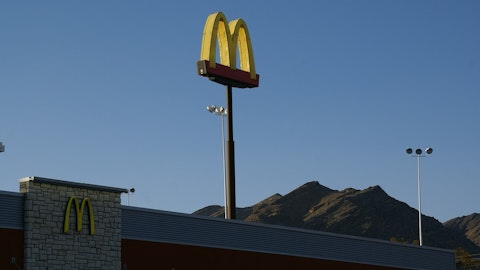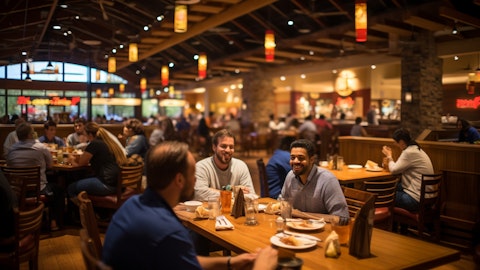Papa John’s International, Inc. (NASDAQ:PZZA) Q4 2023 Earnings Call Transcript February 29, 2024
Papa John’s International, Inc. beats earnings expectations. Reported EPS is $0.91, expectations were $0.73. PZZA isn’t one of the 30 most popular stocks among hedge funds at the end of the third quarter (see the details here).
Operator: Good morning and thank you for standing by. Welcome to the Papa John’s Fourth Quarter and Full Year 2023 Earnings Call and Webcast. At this time, all participants are in a listen-only mode. After the speakers’ presentation, there will be a question-and-answer session. [Operator Instructions] Please be advised that today’s conference is being recorded. I would now like to introduce your host for today’s call, Stacy Frole, Vice President of Investor Relations. Please go ahead.
Stacy Frole: Good morning, and welcome to our fourth quarter and full year 2023 earnings conference call. This morning, we issued our fourth quarter and full year 2023 earnings release. A copy of the release can be obtained on our Investor Relations website at ir.papajohns.com under the News Releases tab or by contacting our Investor Relations department at investor_relations@papajohns.com. On the call this morning are Rob Lynch, our President and CEO and Ravi Thanawala, our Chief Financial Officer. Before we begin, I need to remind you that comments made during this call will include forward-looking statement within the meaning of the federal securities laws. These statements may involve risks and uncertainties that could cause actual results to differ materially from these statements.
Forward-looking statement should be considered in conjunction with the cautionary statements in our earnings release, and the risk factors included in our SEC filings. In addition, please refer to our earnings release for the required reconciliation of non-GAAP financial measures discussed on today’s call. Lastly, let me thank you in advance for asking only one question and getting back in the queue for more follow up. Rob?
Rob Lynch: Thank you, Stacy. Good morning, everyone, and thanks for joining us. Before we get into our 2023 results and our 2024 strategic initiatives, I’d like to take a moment to briefly reflect on the progress that we’ve made over the last 5 years. When I joined Papa John’s in 2019, system-wide sales North America units and operating income were rapidly declining. Since then, our team and franchisees have worked incredibly hard to rebuild the brand and regain consumer loyalty. Their focus and diligence during some of the most dynamic times in our industry has strengthened Papa John’s and positioned us for sustainable growth in the QSR space. To our team members and franchisees, thank you for your commitment and dedication to our customers, our values and our brand and for playing a key role in our success.
Because of these efforts, today, we are reporting another year of record global system-wide sales, our fourth consecutive year of positive North America comps accelerating North America unit growth and adjusted operating income with a 5-year CAGR of approximately 12%. More importantly, we made foundational improvements to our restaurant operations, grew our global restaurant footprint, improved our menu with innovative new products and advanced our digital and marketing platforms to support the evolution of our business model for our next chapter of growth. Our product innovation rooted in our brand promise of better ingredients, better pizza continues to be at the heart of our success. In 2023, we expanded some of our most popular platforms with the Garlic Epic Stuffed Crust Pizza, Doritos, Cool Ranch, Papadias and new Popabytes, including Oreo and Twix Flavors.
We also introduced new innovations like our Crispy Parm pizza, becoming the first large pizza chain to put cheese on the bottom of the crust and brought back fan favorites like our Shaq-a-Roni, pizza. We also executed on our back-to-better 1.0 initiatives, driving operational improvements to deliver better pizza with better service. At our company-owned restaurants, we’ve reduced our out-the-door times nearly 25% to average under 20 minutes today, and we’ve seen our overall customer satisfaction scores continue to improve. This great work has earned us the number one ranking in customer service for the pizza category on the American Customer Satisfaction Index in 2023. We also continue to lean into our domestic third-party aggregator partnerships as sales through this channel reached another high in the fourth quarter, growing more than 10% sequentially and up more than 50% from a year ago.
As we’ve mentioned on past calls, there continues to be a lot of room for category expansion in this channel. We have seen that new competitors entering the marketplace does not necessarily lead to significant volume loss for a brand like ours that has been thriving in this space for years. Our quarter-to-date trends have continued to increase relative to our fourth quarter run rate, and we have increased our market share in this channel. In early January, we announced Back to Better 2.0. These initiatives are designed to drive best-in-class pizza QSR unit economics through higher sales, higher restaurant level margins and higher return on investment on new domestic restaurant openings, our largest and most profitable market. As part of our efforts to enhance our domestic national marketing investment and effectiveness, we went through an extensive advertising and media review process aimed at sharpening our analytics informed approach to marketing and consolidating and optimizing our partners at the national level to drive scale.
As a result of this process, we have shifted to a more productive, nationally focused marketing model. We are increasing the per store investment in the National Marketing Fund from 5% to 6% of sales beginning in the second quarter of 2024, while eliminating the 3% required local spend. The required marketing contribution rate decreases from 8% to 6% and brings the added benefit of an immediate 200 basis points of margin at the restaurant level, along with a bigger impact from their marketing spend. I am thankful for the overwhelming support we received from our franchisees on this change. More than 90% of the system voted in favor, highlighting the confidence our franchisees have in our go-forward marketing strategy. This includes improved audience selection, improved return on ad spend, sustained loyalty and increased cultural buzz.
Our new partners are ramping quickly, and we look forward to sharing how our marketing programs are evolving on future calls. Additionally, we are optimizing our investments in data science and marketing technology to enhance our consumer value perception driven by occasion, daypart and brand. Part of our success in driving positive sales over the past several years has been our ability to strike the right balance between ticket and transaction growth. This is accomplished through our barbell strategy that offers premium innovation while delivering on the needs of our valued customers. We’re focused on delivering value at every segment of our business, whether that is through promoted price points, our core menu or premium innovations. Moving to unit development and how we are incentivizing our franchisees to grow.
In November, we launched a new development incentive to improve the return on capital investment of new domestic restaurants by waiving national marketing fund contributions for the first 5 years. This equates to 600 basis points of annual cost savings in their restaurant P&Ls for the first 5 years or an approximately $360,000 total benefit that will significantly improve the cash-on-cash payback for our developing franchisees who open new units in 2024. This incentive will now extend into 2025, offering 3 years of national marketing fund relief or approximately $216,000 average benefit for new units opened in 2025. Currently, in North America, we have more than 100 units in our pipeline at various stages of development. We are confident that this incentive program, which delivers best-in-class cash-on-cash returns, coupled with improved restaurant margins, customer service levels, marketing efficiencies and technology and analytics platforms will drive sustained development momentum for Papa John’s.
Given the business model changes associated with Back to Better 2.0, these restaurants built in 2024 have the potential to be some of the most profitable restaurants in our system. All of these strategic actions are designed to drive strong top line sales and more volume, which in turn makes our supply chain more productive. We are evolving our commissary business and increasing our fixed operating margin to drive profitable growth for our company while improving supply chain productivity and delivering long-term cost savings for our system. For example, our franchisees can now earn an annual incentive-based rebates as they increase volume in open new restaurants. The incremental volume driven by increased marketing and additional development will reduce the shared supply chain costs across the system.
We are excited about these initiatives and the value that they will create for Papa John’s and for our North America franchisees, not only as they ramp up in 2024, but over the next several years. Now to our international business. Over the past 10 years, we have more than doubled our international footprint and now operate in 50 countries and territories. As we pursue our next phase of international growth, we’re evolving our business model to deliver an enhanced value proposition to our customers and franchisees ensure targeted investments and efficient resource management and better position our largest markets for long-term success. Beyond new unit development, it’s about sustainably and profitably growing all of our restaurants globally.
This past year, we’ve made significant enhancements to our international organization and infrastructure. As part of these efforts, we established international regional hubs in key target regions, Asia Pacific, EMEA and Latin America. These hubs are led by experienced general managers who are partnering with franchisees to create holistic strategies to drive profitable sales in their markets. Our teams are now aligned at the corporate and local levels to execute global best practices in operations, marketing and technology to accomplish our long-term objective of increasing market share in key markets around the world. To support our international teams and franchisees, we are investing in consumer-facing technology, digital infrastructure and enhanced financial and operational reporting.
By investing in expanded ordering capabilities through our website and app and leveraging analytics, we expect to improve conversion, increased customer retention and deliver faster consumer insights to franchisees. This playbook is similar to what we successfully implemented within the U.S. over the past few years, and we expect it to be equally successful as we expand this investment strategy globally. We are also making progress on our repositioning efforts within the U.K. market and expect to improve in profitability during 2024. In 2023, we supported the transition of 61 underperforming U.K. franchised restaurants to other more proven U.K. franchisees. We have seen a significant improvement in the performance of these locations with their fourth quarter comp sales finishing well ahead of the other restaurants within the U.K. market.
In fact, the fourth quarter was the second consecutive quarter of positive comp sales for our U.K. franchisees. If you’ll recall, in June, we announced the transition of 118 U.K. franchise restaurants to company ownership. As anticipated, these new company-owned U.K. restaurants were dilutive to 2023 adjusted operating income by approximately $9 million, which takes into consideration the restaurant’s current year operating loss and the foregone prior year royalties. Similar to the other U.K. restaurants that transition to new owners, we are seeing sequential improvements in the performance of our company-owned restaurants. Together, our company-owned restaurants and franchise locations in the U.K. are reporting positive comps to start 2024, and we continue to explore options to maximize the value and cash flow of our U.K. portfolio, ensuring alignment of the region and its performance with our long-term strategy.
We have also made the decision to close approximately 50 underperforming company-owned restaurants in the second quarter of 2024. These restaurants accounted for roughly two thirds of our operating loss in the U.K. in the fourth quarter. We’ll continue to evaluate our remaining portfolio as well as our franchisee locations, focusing on sales trends, overall profitability and their lease and loan obligations. Through this process, additional strategic closures could occur as we look to drive improved profitability for our remaining stores, optimize trade zones and striking our franchisee base within this important market. In this dynamic global environment, our industry is facing challenges from the potential impact of geopolitical events. We are closely monitoring these situations and will maintain flexibility with our operations in those impacted regions.

We are committed to our international transformational initiatives as we believe they best position us to realize our next phase of global growth and set our largest markets up for long-term success. Now I’d like to turn the call over to Ravi to cover the financial portion of today’s call. Ravi?
Ravi Thanawala: Thank you, Rob, and good morning, everyone. To start, I’d like to echo Rob’s sentiments and thank the entire Papa John system for their focus and commitment to driving forward our strategic priorities during this past year towards our ambition to become the QSR brand of choice for consumers and franchisees around the world. Now for a closer look at our fourth quarter financial results. Global system-wide restaurant sales were $1.34 billion, up 11% in constant currency from the prior year fourth quarter. The increase was largely attributable to the shift in our 2023 fiscal calendar to include a 14th week in the fourth quarter, resulting in approximately 9 percentage points of growth. Outside of the extra week, global system-wide sales were up approximately 2% in the quarter, driven by new restaurant openings and higher North America comparable sales.
Our 2% increase in North America comp sales was a result of increases in transaction and taking growth for both our domestic company-owned restaurants and franchised restaurants. We continue to see higher transactions driven by our aggregator channel, while our ticket growth is supported by the work our teams are doing to enhance customer value perception. International comparable sales decreased approximately 6% in the fourth quarter, of which approximately 4% was related to the ongoing conflict in the Middle East. The remaining 2% was the result of continued pressure across multiple markets, somewhat offset by a 1% positive comp performance from our U.K. franchisees. Total revenue for the fourth quarter were $571 million, up 9% from a year ago.
And while the increase was largely driven by the additional week of operations in 2023 and the consolidation of the U.K. restaurants, we don’t want to lose sight of our positive North America comp sales, which also contributed to our revenue growth in the quarter. Now turning to profits. Adjusted operating income for the fourth quarter was $47 million, up from $38 million a year ago. The key drivers of our fourth quarter growth include a roughly $8 million benefit from the extra week of operations in 2023, an approximate $6 million increase from our domestic company-owned restaurants, driven by higher sales, lower commodity and labor costs, lower insurance expense related to improving auto and workers’ compensation claims experience, leveraging the on-demand labor that aggregators provide through their delivery as a service model and a continued focus on cost discipline while still pursuing strategic growth initiatives.
This growth was partially offset by an approximate $5 million year-over-year impact related to our U.K. acquisition when taking into consideration a fourth quarter 2023 operating loss and a fourth quarter 2022 franchise royalty fees. Higher G&A expenses, as anticipated due to higher performance-based compensation expense when compared with the fourth quarter last year and higher D&A expense as we continue to invest in our restaurants and our technology support, along with the consolidation of the acquired U.K. restaurants in 2023. Adjusted operating margin for the fourth quarter was 8.3%, up from 7.3% a year ago, largely due to the additional week in 2023. Excluding the additional week, adjusted operating margin was up approximately 20 basis points compared with last year.
To provide you a little bit more color on our fourth quarter domestic company-owned restaurant level margins. Overall, these margins improved by approximately 330 basis points compared with the prior year fourth quarter when excluding the 53rd week of operations. Driving the improved margin was approximately 170 basis point benefit from lower food basket costs as we continued to see relief from prior year peaks in proteins, cheese and dough [ph] Labor costs also improved by approximately 90 basis points during the quarter as our restaurant teams continue to do an excellent job executing our service and productivity initiatives. Moving on to cash flow and our balance sheet. For fiscal year 2023, net cash provided by operating activities was $193 million, up from $18 million a year ago.
After deducting $77 million in capital expenditures for the development of new domestic restaurants and investments in technology innovation, we generated free cash flow of $116 million. This is up from $39 million generated in 2022, reflecting the positive flow-through of our overall business performance and higher crude expenses. We ended the year with ample liquidity, $277 million in cash and borrowings available under our revolving credit facility and a gross leverage of 3.2 times. We also returned significant cash to our shareholders in 2023. In total, we repurchased 2.5 million shares or $210 million and paid $59 million in cash dividends. We have approximately $90 million remaining for repurchase under our current share repurchase authorization.
Our capital structure provides us with substantial operating flexibility. We’ll continue to take a disciplined and balanced approach to managing our cash flows, creating shareholder value through a combination of organic growth investments, debt repayments, cash dividends and share repurchases. Turning to development. In the fourth quarter, we added 36 net new units in North America, bringing our total North America net new units in 2023 to 57, a more than 50% increase over last year’s net new unit growth. We now have 3,433 North America restaurants, and we continue to be pleased with the performance of our newly opened restaurants, and we will prioritize our North America development efforts. Internationally, we opened 53 net new units in the fourth quarter, bringing our full year international development to 151 net new units and our total international restaurant count to 2,473.
Now to our outlook. As we look to 2024, we are well positioned to continue driving forward our long-term strategy, and we expect to deliver our fifth consecutive year of positive North America comp sales growth. However, a more cautious consumer is placing more pressure on transactions through our organic delivery channel even as our domestic third-party aggregator sales continue to accelerate. This has led to comps being down approximately 1% for the first 8 weeks of the quarter. As we’ve discussed today, we’re excited about the work our teams are doing to leverage our robust consumer data platforms to influence our media, pricing and menu strategies. We continue to take a balanced approach in this environment, providing the right promotions to our value-oriented customers without risking the erosion of our brand or pricing integrity on our more premium offerings.
We have great confidence in our ability to accelerate North America comps in Q2 and the back half of the year. As such, we expect to deliver 2024 full year comps at the lower end of our long-term target of 2% to 4% growth. Internationally, I’m pleased to report that quarter-to-date, we have seen a moderate sequential improvement in international comps. Positive performance at our U.K. company-owned and franchised restaurants, along with solid sales in other international markets are offsetting the impact from the Middle East conflict. We are in a dynamic environment and continue to maintain a cautious outlook on international comps in 2024. As a reminder, our International segment is the smallest of our operating segments, generating approximately 12% of our adjusted operating income and approximately 7% of our total revenues in 2023.
Currently, we anticipate adjusted operating income in 2024 to be between $153 million and $163 million. At the midpoint, this is an approximate 6% increase from 2023 when excluding the favorable impact of the 53rd week. Year-over-year tailwinds include the increase to our fixed commissary margin, our international transformation initiatives, including the closure of approximately 50 underperforming company-owned U.K. restaurants in the second quarter and an increase in North America sales as we accelerate development and deliver another year of positive comp sales. Offsetting these tailwinds will be higher G&A expenses as performance-based compensation ramps back up and a higher G&A expense, which is expected to be between $70 million and $75 million in 2024, resulting from the higher tech investments over the last 3 years.
In terms of other nonoperating expense items, we expect net interest expense to be between $40 million and $45 million, our capital expenditures to be between $75 million and $85 million and our tax rate to be between 23% and 26%. I should note that our first quarter tax rate will be higher due to an anticipated shortfall from the vesting of long-term equity plans, resulting in an additional tax expense of roughly $2 million in the quarter when compared with the prior year period. From a development perspective, the North American market is the most attractive development for Papa John’s, and we remain committed to accelerating our domestic footprint moving forward. In 2024, we expect net new unit growth for North America to increase more than 20% relative to 2023 net unit openings.
From an international perspective, over the last 2 years, conflicts in the Ukraine and the Middle East, combined with an overall dynamic geopolitical environment has changed our run rate of new international restaurant openings for 2024. As a result, we are taking a cautious approach and expect growth openings between 100 and 140 new international restaurants. We will also not hesitate to make additional strategic restaurant closures to improve marketplace health or exit unprofitable restaurants. As such, our anticipated openings could be offset by the closure of underperforming company-owned and franchised restaurants to enhance long-term profitability. Over the long term, we have great partners who want to grow and are committed to reaching our long-term development targets of 5% to 7% net new units annually.
In summary, the Pope John’s team has delivered a solid fourth quarter and full year 2023. We’re focused on executing our long-term growth strategy and implementing our Back to Better 2.0 and international transformation initiatives. I’m proud of the Papa John’s team and our strategic plans to deliver growth. Now I’ll turn the call back over to Rob for some final comments. Rob?
Rob Lynch: Thank you, Ravi. At Papa John’s commitment to our values is top of mind, and we are steadfast in creating and nurturing a culture of putting people first. Capping off an incredible year we were recognized by Forbes on their list of world’s best employers for the second year running, while also included in the Forbes list of Best Employers for Diversity, ranking first among pizza companies. As we continue to advance our strategic priority of building a culture of leaders who believe in diversity, inclusivity and winning, we will continue to support our communities, team members and franchisees. I am incredibly proud of the work that the entire Papa John’s system is doing to drive forward our strategic long-term plan.
Our North America business is prime for growth as we execute on our Back to Better 2.0 initiatives. We are continuing to expand our share within the domestic third-party aggregator delivery channel. We are introducing new menu innovations, and we are optimizing our profitability by leveraging our robust consumer data platforms. Additionally, our improving supply chain productivity and accelerating North America development will deliver improved bottom line economics systemwide. In summary, Papa John’s has proven that its business fundamentals performed well through all economic cycles. Our leadership team has the experience and vision required to move our company forward and drive results. Our brand equity is stronger than ever, and our brand awareness continues to grow globally.
We have ample development opportunities to drive sustainable, profitable expansion and significant earnings potential. All this means that we are well positioned to deliver shareholder value for the long term. At this point, I would like to open up the call for questions.
See also 11 Best Brewery and Distillery Stocks to Buy Now and 13 Best Diversified Dividend Stocks To Invest In.
Q&A Session
Follow Papa Johns International Inc (NASDAQ:PZZA)
Follow Papa Johns International Inc (NASDAQ:PZZA)
Operator: Thank you [Operator Instructions] And our first question coming from the line Sara Senatore from Bank of America. Your line is open.
Sara Senatore: Thank you. Just a quick clarification and then a question. You mentioned that aggregator sales grew more than 50% year-over-year in the quarter. And I think given what you said about quarter-to-date in the first quarter, it sounds like that gap remains pretty wide with your proprietary channels. I think you were sort of suggesting that it’s a response maybe to more promotional intensity in — that may be affecting the proprietary channels and perhaps less so the aggregators. So I just — I wanted to make sure I understood that correctly. And then the question was about international unit growth. To what extent is the Middle East, the primary driver, I think it’s a relatively small share of your total international store base versus perhaps what you’re seeing in other markets and the extent to which those are more market specific? Thanks.
Rob Lynch: Thanks, Sara. So what I would tell you is that and I think we stated this in the past that about right now, the aggregator channels, we believe to be about 50% incremental to our core channels. So 50% of that growth would be coming from our core business. Obviously, we have initiatives in place to try to mitigate the — any of that shift in volume from our core business to the aggregators. So it’s not a one-for-one transfer, but 50% of the aggregator volume comes from our core channels. And in regards to the Middle East, the Middle East has actually become a bigger part of our international footprint. We have about 2,400 units internationally and the Middle East represents about 400 – 450 of those units. So it’s become about 25 – I’m sorry, about 20% of our international footprint.
And so – and it is one of our fastest-growing developing regions. And so we did see a pretty significant impact in Q4 to our global development number. And that did definitely impact that number in 2023. We had 68 new units in that region in 2022 alone. So it is something we’re watching closely. We have great franchisees there. They have built and been excited about building and have rapidly grown their development agreements in the region. So it is something we’re watching closely. And we’ll have a short-term impact as called out in the call on the 2024 numbers.
Sara Senatore: Thank you very much.
Operator: Thank you. One moment for our next question. And our next question coming from Peter Saleh with BTIG. Your line is open.
Peter Saleh: Yes. Great. Thanks. So I was hoping maybe you guys could elaborate a little bit on the same-store sales trends that you’re currently seeing? It seems like you guys ended the year on a positive note, but starting the year on a negative note, but we’re also seeing some strength in that aggregator channel. So I mean, maybe just coming back a little bit more to Sara’s question. Can you just give us a little bit more color on the same-store sales and maybe what’s changed quarter-to-date? Thanks.
Rob Lynch: Yes. I mean I think the consumer has changed a little bit. I think we’re seeing some softness in general in the industry, particularly in January. We have seen some strength in February. We were the number three brand ordered on Uber Eats for the Super Bowl. So despite some challenging situations in January, we’ve seen some resiliency. But what I will tell you, Peter, is we always knew that Q1 was going to be our toughest quarter coming into this year. All of the things, all the plans that we have built to deliver strong comp sales growth this year really take effect in Q2. So we’re about 4 weeks away from a 20% increase in media, a new advertising campaign hitting and we’ve got great new innovation coming in April as well.
So — and those impacts are going to sustain through the balance of the year. So we are really excited about Q2, 3 and 4 because of all the back to better 2.0 things that we announced back in January. So we definitely see strong sales momentum looking forward despite a little bit of a soft start here in January.
Peter Saleh: Thank you.
Operator: Thank you. And our next question coming from the line of Lauren Silverman from Deutsche Bank. Your line is open.
Lauren Silverman: Thank you very much. I wanted to ask about the recently announced new development incentives in the U.S. Can you just talk about your early conversations with franchisees, any inflection and increase commitments franchisees trying to pull forward openings into 2024? Thank you very much.
Rob Lynch: Yes. There’s definitely a lot of excitement. We’ve had a lot of conversations last year in 2023, we delivered 57 net new units in North America. We’re going to grow that by at least 20% in 2024. But we’re working diligently with our franchisees to help them accelerate. That being said, we also have extended that development incentive into 2025 at this point. It’s not exactly the same. If they get them built in 2024, it’s 5 years of national marketing fund relief, if they get them built in 2025, it’s three years of relief. So we wanted to make sure that all of the franchisees that are coming to us saying, hey, I want to take advantage of this, but I’m not far enough into the development cycle that these stores might move into Q1 next year.
We wanted to make sure that they had some incentive to do that. So we’re definitely seeing excitement. We’re definitely leveraging that incentive. But I will tell you, beyond the incentive, Papa John’s is set up for long-term development growth. It’s not just ’24 and ’25. We’re really trying to kick start this engine, but we have great returns on new store development. Our AUVs have gone up from $850,000 to on average $1.2 million over the last 5 years. So at the same time, we’ve been really good about managing restaurant profitability as evidenced by 330 basis points of year-over-year growth in our restaurant margins in Q4. So this incentive is definitely a trigger, but this isn’t the reason why people are going to develop Papa John’s. They’re going to develop Papa John’s because it’s a long-term commitment, 10-, 20-year cycles of business that they believe will continue to deliver returns far into the future beyond these incentives.




